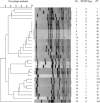Staphylococcus aureus isolates carrying Panton-Valentine leucocidin genes in England and Wales: frequency, characterization, and association with clinical disease - PubMed (original) (raw)
Staphylococcus aureus isolates carrying Panton-Valentine leucocidin genes in England and Wales: frequency, characterization, and association with clinical disease
A Holmes et al. J Clin Microbiol. 2005 May.
Abstract
Staphylococcus aureus isolates carrying the genes that encode for Panton-Valentine leucocidin (PVL), a highly potent toxin, have been responsible for recent outbreaks of severe invasive disease in previously healthy children and adults in the United States of America and Europe. To determine the frequency of PVL-positive isolates sent to the Staphylococcus Reference Unit (United Kingdom) for epidemiological purposes, we tested 515 isolates of S. aureus, and 8 (1.6%) were positive for the PVL locus. A further 470 isolates were selected to explore the association of PVL-positive S. aureus with clinical disease. Of these, 23 (4.9%) were PVL positive and most were associated with skin and soft tissue infections (especially abscesses). The PVL genes were also detected in isolates responsible for community-acquired pneumonia, burn infections, bacteremia, and scalded skin syndrome. Genotyping by pulsed-field gel electrophoresis and multilocus sequence typing revealed that the PVL-positive isolates were from diverse genetic backgrounds, although one prevalent clone of 12 geographically dispersed methicillin-resistant S. aureus (MRSA) isolates was identified (ST80). All 12 isolates were stapylococcal cassette chromosome mec type IVc, had an agr3 allele, and shared a common toxin gene profile (sea-see, seg-sej, eta, etb, and tst negative but etd positive). ST80 strains with similar genetic characteristics have been responsible for community-acquired infections in France and Switzerland. The remaining PVL-positive isolates were mostly methicillin-sensitive S. aureus and belonged to 12 different sequence types, including ST22 and ST30, which are closely related to the most prevalent MRSA clones in United Kingdom hospitals, EMRSA-15 and EMRSA-16, respectively.
Figures
FIG. 1.
PFGE patterns and phylogenetic tree of 30 S. aureus isolates carrying PVL genes. SmaI macrorestriction patterns were digitalized and analyzed to calculate Dice coefficients of correlation and to generate a dendrogram by unweighted-pair group method using average linkage clustering. Numbers 1 through 30 correlate with those in Table 2.
Similar articles
- Polyclonal emergence and importation of community-acquired methicillin-resistant Staphylococcus aureus strains harbouring Panton-Valentine leucocidin genes in Belgium.
Denis O, Deplano A, De Beenhouwer H, Hallin M, Huysmans G, Garrino MG, Glupczynski Y, Malaviolle X, Vergison A, Struelens MJ. Denis O, et al. J Antimicrob Chemother. 2005 Dec;56(6):1103-6. doi: 10.1093/jac/dki379. Epub 2005 Oct 13. J Antimicrob Chemother. 2005. PMID: 16223937 - High diversity of Panton-Valentine leukocidin-positive, methicillin-susceptible isolates of Staphylococcus aureus and implications for the evolution of community-associated methicillin-resistant S. aureus.
Monecke S, Slickers P, Ellington MJ, Kearns AM, Ehricht R. Monecke S, et al. Clin Microbiol Infect. 2007 Dec;13(12):1157-64. doi: 10.1111/j.1469-0691.2007.01833.x. Epub 2007 Oct 19. Clin Microbiol Infect. 2007. PMID: 17949441 - The role of the Panton-Valentine leucocidin toxin in staphylococcal disease: a systematic review and meta-analysis.
Shallcross LJ, Fragaszy E, Johnson AM, Hayward AC. Shallcross LJ, et al. Lancet Infect Dis. 2013 Jan;13(1):43-54. doi: 10.1016/S1473-3099(12)70238-4. Epub 2012 Oct 26. Lancet Infect Dis. 2013. PMID: 23103172 Free PMC article. Review. - Whole-genome sequencing links cases dispersed in time, place, and person while supporting healthcare worker management in an outbreak of Panton-Valentine leucocidin meticillin-resistant Staphylococcus aureus; and a review of literature.
Mehra R, Meda M, Pichon B, Gentry V, Smith A, Nicholls M, Ryan Y, Woods J, Tote S. Mehra R, et al. J Hosp Infect. 2023 Nov;141:88-98. doi: 10.1016/j.jhin.2023.08.019. Epub 2023 Sep 9. J Hosp Infect. 2023. PMID: 37678435 Review.
Cited by
- Effect of silver nanoparticles and REP-PCR typing of Staphylococcus aureus isolated from various sources.
Elghazaly EM, Torky HA, Tawfik RG. Elghazaly EM, et al. Sci Rep. 2024 Sep 23;14(1):21997. doi: 10.1038/s41598-024-71781-w. Sci Rep. 2024. PMID: 39313528 Free PMC article. - Rate of Beta-Lactam Resistance and Epidemiological Features of S. Aureus-Associated Bovine Mastitis in Cross-Bred Ethiopian Cows: Systematic Review.
Dagnaw M, Bazezew M, Mengistu B, Anagaw B, Mebratu AS. Dagnaw M, et al. Vet Med (Auckl). 2024 Feb 27;15:39-55. doi: 10.2147/VMRR.S415339. eCollection 2024. Vet Med (Auckl). 2024. PMID: 38433734 Free PMC article. Review. - Ocular Bacterial Infections: A Ten-Year Survey and Review of Causative Organisms Based on the Oklahoma Experience.
Astley RA, Mursalin MH, Coburn PS, Livingston ET, Nightengale JW, Bagaruka E, Hunt JJ, Callegan MC. Astley RA, et al. Microorganisms. 2023 Jul 13;11(7):1802. doi: 10.3390/microorganisms11071802. Microorganisms. 2023. PMID: 37512974 Free PMC article. - Prevalence of mecA and Panton-Valentine Leukocidin Genes in Staphylococcus aureus Clinical Isolates from Gaza Strip Hospitals.
El Aila NA, Al Laham NA, Naas T. El Aila NA, et al. Microorganisms. 2023 Apr 28;11(5):1155. doi: 10.3390/microorganisms11051155. Microorganisms. 2023. PMID: 37317129 Free PMC article.
References
- Becker, K., R. Roth, and G. Peters. 1998. Rapid and specific detection of toxigenic Staphylococcus aureus: use of two multiplex PCR enzyme immunoassays for amplification and hybridization of staphylococcal enterotoxin genes, exfoliative toxin genes, and toxic shock syndrome toxin 1 gene. J. Clin. Microbiol. 36:2548-2553. - PMC - PubMed
- Boussaud, V., A. Parrot, C. Mayaud, M. Wislez, M. Antoine, C. Picard, F. Delisle, J. Etienne, and J. Cadranel. 2003. Life-threatening hemoptysis in adults with community-acquired pneumonia due to Panton-Valentine leukocidin-secreting Staphylococcus aureus. Intensive Care Med. 29:1840-1843. - PMC - PubMed
- Bynoe, E. T., R. H. Elder, and R. D. Comtois. 1956. Phage-typing and antibiotic-resistance of staphylococci isolated in a general hospital. Can. J. Microbiol. 2:346. - PubMed
Publication types
MeSH terms
Substances
LinkOut - more resources
Full Text Sources
Other Literature Sources
Medical
